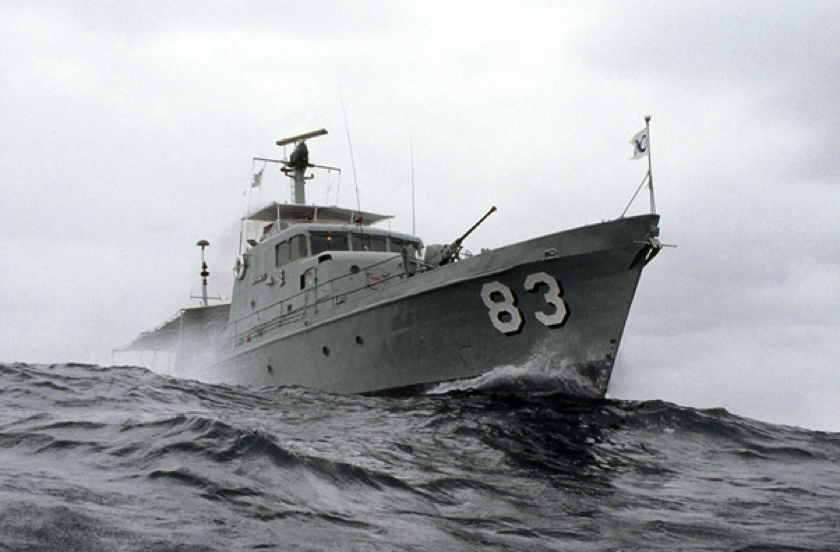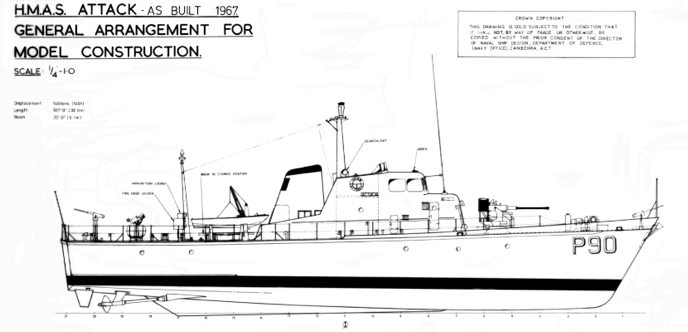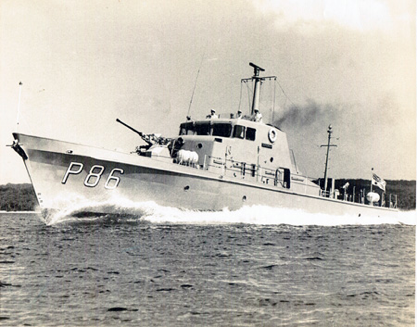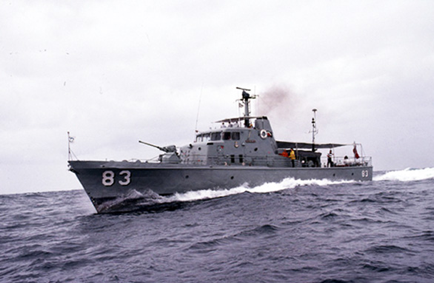April 2019
By Dennis J Weatherall JP TM AFAITT(L) LSM
Volunteer Researcher, Naval Historical Society of Australia
Patrol boats have proven to be the most flexible and versatile elements of the Australian Defence Force (ADF) since World War 2. Every day they are at sea patrolling Australian waters and protecting our national interests. They play an active role in the enforcement of Australian legislation pertaining to; illegal immigration, fishing, quarantine and smuggling.
Between World War 2 and 2019 the Royal Australian Navy has operated five classes of patrol boats commencing with the Bathurst class built between 1940 and 1942. Then followed the Ton class, Attack class, Fremantle class and in current service, the Armidale class.
Experience during the period of Indonesian Confrontation (1963-6) with the Ton class demonstrated the value of small vessels for patrol and interdiction tasks. However, the Ton class propulsion system was not suited to loitering and they were expensive to maintain. This experience led the RAN to introduce the Attack class to conduct patrol work in Australian territorial waters.
This paper examines the design, construction and operations of the Attack class and provides some insight into their habitability.

commissioned 6 February 1968. ANMM image
User Requirement
The requirement for a new Royal Australian Navy Patrol Boat design commenced in May 1963 with an official request from Navy for a preliminary feasibility study for a boat of simple characteristics, around 70-80 feet in length with a speed of approximately 12 knots, and accommodation for a minimum of 2 Officers, 2 Petty Officers and 10 Junior Sailors.
From these initial and additional requirements, the final design developed by Department of Navy naval architects resulted in a vessel that could carry out; general duties, harbour defence, pursuit and interception tasks.
The final design required the following;
| Capabilities:
• Search & rescue • Seaward defence • Coast Watching • Target towing • Boarding operations
|
Navigation:
· Radar, transistorised light weight commercial unit · Gyro compass, similar to Arma Brown commercial units · Magnetic compass, · Echo sounder of a type similar to Ferrograph, a Trident Log with a bridge repeater · Training: for Junior Officers and sailors (PNF and Reserve) in ship handling |
| Training
for Junior Officers and sailors (PNF and Reserve) in ship handling |
Communications
A package for both external and internal use for control and navigation.
|
| Speed
Maximum, 23 knots Cruising, 15 knots |
Weapons
A power-operated single Bofor gun on forecastle immediately forward of superstructure with similar mount aft. Provision for small arms and ammunition |
| Endurance
At maximum continuous speed: 500 miles At cruising speed: at least 1500 miles Water & victuals: 14 days |
Accommodation
to approved standards, fitted with air-conditioning for tropical area operation |
| Dimensions
length 100-120 ft and draught of 5-8 ft |
Life-saving equipment
RAN standard
|
| Propulsion
Twin screw, simple and reliable in operation |
Ships Boat
14 ft dingy (approximately) |
Delivered Capabilities and Specifications
The boat ‘as delivered’ generally met the required specifications, e.g. length 107.5 feet (32.76M), draught 6.2 feet (1.9M) and a speed of 24 knots. Full details of the boat as delivered are at Annex A.

Service Life and Disposal
The original plan was to build twenty boats, although the class type was designated the Attack, the boat bearing the class name was the tenth pennant number allocated, fifth launched and second commissioned four days after Aitape # P84. Pennant numbers ran from 81-95 and 97-101, (20 numbers) but Pennant number 96 was never allocated, nor could I find a reason for skipping this specific number.

The Attack class (A) Boats were built at two Queensland engineering works; Evans Deakin (Brisbane) built 13 and Walkers Ltd (Maryborough) built 7.
Five Patrol Boats were purpose built for New Guinea service and named accordingly. They were used for patrol and general duties in Australian and surrounding waters before transfer to the PNG Defence Force. The boats destined for New Guinea service were HMAS Aitape, Samarai, Ladua, Lae and Madang. These vessels, after Independence, were retitled HMPNG Ships. The table provided in Annex B lists all twenty vessels built; by whom, pennant numbers, dates laid down and dates launched and commissioned.
The Attack class gave good service over more than two decades. HMAS Bayonet, built by Walkers Ltd was the last boat launched (6 November 68) and commissioned on 22 February 69. The last boat to decommission was HMAS Aware on 17 July 1993.
Five boats were gifted to the PNG Government; Aitape, Samarai, Ladava, Lae and Madang. Nine were either gifted or purchased by Indonesia. These were:
| RAN Name | TNI Name |
| Acute P81 | KRI Sikuda # 863 |
| Archer P86 | KRI Siliman # 848 |
| Ardent P87 sold privately, then bought by Indonesia. | KRI Tenggin # 865 |
| Assail P89 | KRI Sigurot # 864 |
| Attack P90 | KRI Sikuda # 863 |
| Bandolier P95 | KRI Sibarau # 847 |
| Barbette P97 | KRI Siada # 862 |
| Barricade P98 | KRI Sigalu # 857 |
| Bombard P99 | KRI Siribura # 859 |
Two boats were sunk as targets, Adroit on 8 August 1994 and Buccaneer on 8 October 1988.
Loss of HMAS Arrow
HMAS Arrow floundered alongside Stokes Hill Wharf during Cyclone Tracy on 25 December 1974 with the loss of two lives, Petty Officer Leslie Catton and Able Seaman Ian Rennie. Arrow and Attack had attempted to sail Port Darwin and ride out the cyclone at sea, but neither vessel made it out of the port. Arrow was unlucky and was blown under Stokes Hill Wharf and wrecked. Attack was driven ashore at Doctor’s Gully without sustaining any casualties. Arrow was re-floated by DT1 on 13 January 1975 by attaching pontoons to her hull and, with the assistance of tugs, the wreck was towed underwater to the shallows of Frances Bay, where she was surveyed, written off as a wreck and put up for sale.

A local businessman purchased what was once a proud patrol boat, his idea was to restore her, but it proved far too expensive, therefore a decision was made to break her up where she lay.
HMAS Advance was the third boat in Darwin at the time. She escaped damage at sea. One of HMAS Arrow’s name boards is proudly displayed in the Mess at HMAS Waterhen, once her home base.

HMAS Advance is the last remaining Attack class patrol boat maintained as an operating exhibit by the Australian National Maritime Museum in Darling Harbour, Sydney. Advance is a proud reminder of the twenty boats built between 6 July 1967 and 6 November 1968 to protect Australia’s 200nm economic zone, fishing rights and just about any other task directed. They welcomed fleeing South Vietnamese after the Fall of Saigon in April 1975, and towed many a craft safely to our shores. They were work-horses with more sea time than many major fleet units. Once a “boat-man”, you always wished to stay in what was often referred to as “McHale’s Navy”. There wasn’t much of our extensive coastline that we didn’t pass or “drop the pick” in some secluded bay or river entrance, from Cooktown into the Gulf and down the West Australian coast.
Life in an ‘A’ Boat
The combination of a small, relatively junior crew, remote area operations and cycle of 6 weeks on patrol and 2 weeks in home port resulted in close-knit self-reliant ships companies very proud of their boat. Dress standards in the tropics were relaxed with the ships ‘T’ shirt, shorts and sandals frequently dress of the day. Multi-tasking was essential for the conduct of evolutions such as boarding operations and during leave periods. Young and inexperienced hands quickly learnt under guidance from the CO and senior sailors. Training in an ‘A’ boat occurred naturally.
Habitability was adequate but some design shortcomings created frustrations. ‘A’ boats were not designed for crew comfort in heavy sea states! Operations in conditions above sea states 4 and 5 (moderate to rough seas) curtailed many activities particularly boarding operations. They rolled uncomfortably in moderate conditions often creating havoc due to design issues. As an example, the galley range door which was oriented longitudinally would fly open in heavy seas. Local modifications such as attaching a gate bolt to keep what was cooking in the oven were necessary. As an aside, one day before the modification was carried out, I found our LSCK chasing half-baked chickens across the deck after we hit some rather heavy seas! You can imagine the mess of oil (from the chickens), the baking tray and one rather irate cook chasing scran across the deck!
The senior sailor’s bathroom located in the peak of the bow presented another challenge. It was some real fun sitting on the heads when underway heading into a forceful sea state, and an impossibility to shower without a very wet deck when the shower curtain swung to starboard at 40-plus degrees. Laundry facilities were ‘Heath Robinson’ with a washing machine lashed to the mast for use alongside when adequate fresh water was available. The engine room doubled as a drying room.
Throughout their service Attack class boats developed a proud and respected reputation so much so that the Australian Broadcasting Commission produced a television series based on actual events with which they dealt. They certainly lived up to their short sharp mottos which are listed in Annex C.
Attack Class Successor: The Fremantle Class
Planning for the new Fremantle class patrol boats commenced in 1970. Experience gained from operating twenty Attack class boats identified numerous areas for improvement in the new design. By September 1970 the Navy proposed construction of ten additional new patrol boats to commence entering service between 1976 and 1980. These additional vessels would augment the Attack class and also replace the two General Purpose Vessels HMAS Bass and Banks.

The acquisition of replacement patrol craft was announced in April 1975 with eleven shipbuilders invited to tender. On 22 September 1977 the Minister of Defence (James Killen) announced the PCF450 design had been selected and fifteen boats would be built at a cost of AUD 115 million.
The lead vessel HMAS Fremantle was built in the UK by Brooke Marine of Lowestoft. The remainder were built in Australia by North Queensland Engineers and Agents. Fremantle was allocated pennant number 203 and following commissioning, 17 March 1980 made one of the longest duration delivery voyages in RAN history taking 82 days. Fremantle arrived at her home base, HMAS Waterhen on 27 August 1980. She had sailed 14,509 nautical miles, probably the longest voyage undertaken by a single RAN patrol boat.
With HMAS Fremantle came the new class of patrol boats and additional duties as they were integrated into the Fleet. Attack class boats progressively handed over the reins to the Fremantles until they were all decommissioned. In turn, the Fremantles were superseded by the Armidale Class, but that is another story!
Annexes
- Attack Class Patrol Boat: Delivered Capabilities and Specifications
- Attack Class Patrol Boat: Key Dates
- Attack Class Patrol Boat: Mottos
References:
- Personal experience from boats on which I served (Dennis Weatherall)
- Design of Patrol Boats for RAN – J.J. Follan M.R.I.N.A. (Royal Institution of Naval Architects Australia)
- Australian Ships of War – John Bastock Published 1975 Pages 372-382
- Welcome to the Armidale Class, Semaphore February 2006, Issue 4
- Australian Patrol Combatants, April 2010, Semaphore 2010 Issue 3,
- HMAS Arrow, Sea Power Centre Australia Website, accessed 30 March 2019
Annex A
Attack Class Patrol Boat: Delivered Capabilities and Specifications
The following describes the Attack class as delivered to the RAN
Displacement: 100 tons standard, 146 tons fully loaded, length 107.5 ft (32.8m), beam 20 ft (6.1m), draught 7.3 ft (2.2m) at full load, propulsion 2×16 cylinder Paxman YJCM diesel engines 2 shafts, speed 24 knots (44 km or 28 mph), complement 3 Officers/4 Senior Sailors/12 Junior Sailors, armament 1×40 mm Mk 7 Bofor gun, 2 x .50 calibre machine guns, sufficient SLR and AR mix of rifles and hand guns.
Hull: The Attack class main hull was constructed of steel frame, bulkheads, deck beams were designed in mild steel of all-welded construction. The superstructure, funnel and masts were constructed of aluminium alloy of all-welded construction and “huck-bolted[1]” to the main hull structure.
Accommodation was located forward in the bow for 4 Senior Sailors. Senior Sailors’ bunks were two up port and starboard. Officers were accommodated in 2 cabins; Executive officer and Navigator, in a 2-off cabin forward opposite the radio office before entering the Senior Sailors’ Mess, starboard-side. The CO had a single cabin aft of the forward ladder to the lower deck and adjacent the magazine. All three officers shared a bathroom and heads directly opposite the forward ladder, accessible from the wardroom flat. These spaces were lined, with a white laminate and insulated, joins were neatly covered with natural timber trim. The Junior Sailors’ Mess was located aft immediately behind the engine room and forward of the tiller flat. Bunks were steel constructed, 3 up on the port side and 3 on the starboard side, split 6 forward and 6 aft, with a coat locker dividing sleeping area from the general mess.
Fuel Tank Capacity: Diesel, 6 main tanks of 20 tons capacity; 2 ferrying tanks of 2.5 tons;
Fresh Water Tank Capacity: normal capacity 4 tanks of 6.5 tons. Fresh water maximum capacity was 7.5 tons. These fresh water tanks were built into the hull. In order to conserve fresh water, an alternative salt water supply (if needed) could be operated in all three bathroom shower heads. When fresh water was scarce and top-up was impossible due to location, passing rain squalls were a welcome shower alternative on the quarter deck.
Steering Gear was fitted as a “Mathway” light weight power-assisted unit. It could be operated from either the Bridge, Wheelhouse or the emergency steering position in the Tiller flat, also known as the Bosun’s Store aft, directly over the ship’s rudder area. In the event of any hydraulic failure, this equipment could function without any power assistance but extremely hard on the arms.
Deck Machinery on the forecastle consisted of an anchor windlass of one cable lifter and two warpends driven by a 4.5 hp electric motor through an enclosed worm reduction gearbox. The windlass was also arranged for emergency hand operations.
Anchor was a 180 pound (81.8 kg) “Danforth” type fitted with 11/16 inch chain cable.
Galley was located immediately aft of the Wheelhouse on the main deck before exiting the forward superstructure. All equipment was electric and consisted of one single oven range with four hot plates and a grill plate. A 15 cubic feet upright refrigerator, one 7.5 gallon hot water urn for brews (always ready for use 24 hrs/day) and one use-all mixer/mincer.
Provisions Room – located at the bottom of the aft ladder into the Junior Sailors’ Mess directly opposite their bathroom, it took up the entire compartment, 21 cubic ft capacity in which we stored all meats, frozen milk, bread and the beautiful, pre-packed “guinea pig” vegetables such as broccoli, sweet corn and peas. Each Mess (x 3) also had a 5 cubic ft ready-use refrigerator – they also suffered from the same fore & aft placement onboard ship as our galley stove/range and often the fridge lock would spring open and whatever was inside quickly deposited itself on the deck!
Annex B
Attack Class Patrol Boat: Key Dates
The following table provides key dates (builder, pennant number, date laid down, launch and commission) for all twenty boats.
| Name | Pennant
Number |
Builder | Launch
Date |
Commissioning Date | Decommissioning Date | History Post RAN Service |
| Acute | P81 | Evans Deakin | 26/8/67 | 26/4/68 | 6/5/83 | Indo KRI Sikuda # 863 |
| Adroit | P82 | Evans Deakin | 3/2/68 | 17/8/68 | 28/3/92 | Sunk as target, August 1994 |
| Advance | P83 | Walkers Ltd | 16/8/67 | 24/1/68 | 6/2/88 | Museum, ANMM Sydney |
| Aitape | P84 | Walkers Ltd | 6/7/67 | 13/11/67 | 14/11/74 | Transferred to HMPNGS, scuttled 1995 |
| Samarai | P85 | Evans Deakin | 14/7/67 | 1/3/68 | 14/11/74 | Transferred to HMPNGS |
| Archer | P86 | Walkers Ltd | 2/12/67 | 15/5/68 | 21/5/74 | Indo KRI Siliman # 848 |
| Ardent | P87 | Evans Deakin | 27/4/68 | 26/10/68 | 6/1/94 and Reclassified as TRNG NAV # A243. Paid off Dec. 1998 | Sold to Pvte Indo 2002 KRI Tenngeri #865 |
| Arrow | P88 | Walkers Ltd | 17/2/68 | 3/7/68 | Lost in Darwin, 25/12/74 Cyclone Tracy | |
| Assail | P89 | Evans Deakin | 18/11/67 | 21/7/68 | 18/10/85 | Indo KRI Sigurot
# 864 |
| Attack | P90 | Evans Deakin | 8/4/67 | 17/11/67 | 21/2/85 | Indo KRI Sikuda # 863 |
| Aware | P91 | Evans Deakin | 7/10/67 | 21/6/68 | 17/7/93 | Sold Pvte, scrapped 2011 |
| Ladava | P92 | Walkers Ltd | 11/5/68 | 13/11/67 | 14/11/74 | T/fs to HMPNGS |
| Lae | P93 | Walkers Ltd | 5/10/67 | 3/4/68 | 14/11/74 | Transferred to HMPNGS |
| Madang | P94 | Evans Deakin | 10/10/68 | 28/11/68 | 14/11/74 | Transferred to HMPNGS |
| Bandolier | P95 | Walkers Ltd | 2/10/68 | 14/12/68 | 16/11/73 | Indo KRI Sibarau # 847 |
| Barbette | P97 | Walkers Ltd | 10/4/68 | 16/8/68 | 15/6/84 | Indo KRI Siada
# 862 |
| Barricade | P98 | Evans Deakin | 29/6/68 | 26/10/68 | 20/5/82 | Indo KRI Sigalu #857 |
| Bombard | P99 | Walkers Ltd | 6/7/68 | 5/11/68 | 12/9/83 | Indo KRI Siribura # 859 |
| Buccaneer | P100 | Evans Deakin | 14/9/68 | 11/11/69 | 27/7/84 | Sunk as target 8/10/88 |
| Bayonet | P101 | Walkers Ltd | 6/11/68 | 22/2/69 | 26/6/88 | Scuttled 21/9/99 in Victoria |
Annex C
Attack Class Patrol Boat Mottos
The following is a list of mottos allocated to each boat.
P81 Acute “Swift to the Point”
P82 Adroit “Quick and Secure”
P83 Advance “Never Look Back”
P84 Aitape “Tread Warily”
P85 Samarai “United We Stand”
P86 Archer “Swiftly Sure”
P87 Ardent “Flame and Fury”
P88 Arrow “Straight as an Arrow”
P89 Assail “Cut Deep”
P90 Attack “Never Waver”
P91 Aware “Forever Alert”
P92 Ladava “Fight the Good Fight”
P93 Lae “Dare All”
P94 Madang “Our Ship Your Shield”
P95 Bandolier “Dressed to Kill”
# 96 not allocated. Reason unknown
P97 Barbette “Taut and Trim”
P98 Barricade “They Shall Not Pass”
P99 Bombard “Hit Hard”
P100 Buccaneer “Seek and Find”
P101 Bayonet “We Fix”
[1] Huck-bolting is a patterned fastening, similar to a rivet, used frequently to fasten unlike metals together such as mild steel and aluminium. It’s a screwed thread with a clamp nut.




